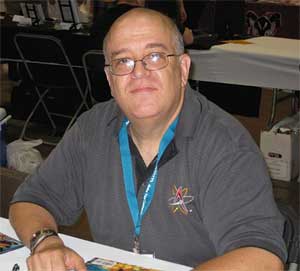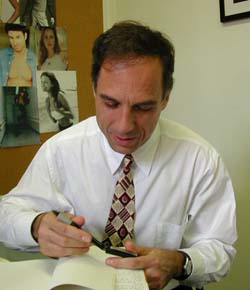It is doubtful that Best Erotic Comics 2008 (Last Gasp, $19.95), edited by Greta Christina, will receive any kind of mainstream reviewing attention. The volume has, much like Tim Pilcher and Gene Kannenberg, Jr.’s Erotic Comics (released earlier this year), even eluded the seemingly more permissive pastures of alt-weeklies. But it does warrant some attention, if only because erotica, fantasy, comics, and horror remain some of the only areas in American culture where certain forms of human behavior can be portrayed without needless censorship.
Like many anthologies, this volume relies on a few notable names to draw attention. Work from Daniel Clowes, Phoebe Gloeckner, and Gilbert Hernandez is included. In the case of Clowes and Hernandez, these are reprints from material that anyone remotely stepped in comics is likely to know about: excerpts from David Boring and “Kisses for Pipo,” respectively. Gloeckner’s one-page contribution, entailing a medical illustration of a blowjob, is, like most of her work, especially striking. But some of the more juvenile inclusions, such as Ralf Konig‘s “Roy & Al: Sniffing Around,” bog down the collection. Konig’s work, which chronicles two dogs watching two gay lovers copulate, is artistically crude and predictable, too taken with hysterical text balloons (“OH, YOU LOVE ME?! SO C’MON, GIMME A KISS, MY TREASURE!!”) and an uninteresting situation that made me long for Catherine Breillat’s wit.
Toshio Saeki‘s excerpt from “Inkenka” captures some of the taboo-breaking, quasi-hentai images that Saeki is known for: a doctor performing cunnilingus on a legless girl bandaged to a bed, and a man hacksawing a clitoris (with a distressed observer seen looking through the window at the top of the illustration). But these images don’t go nearly as far as Saeki’s other work and the inclusion here feels more like perfunctory padding.
One of the more surreal inclusions is Dave Davenport‘s “Gigantic,” which features King Kong trying to get it on with Godzilla. Davenport knows how to get much out of his shading, and his paneling is interesting, but he doesn’t explore the intriguing possibility of how the human population, seeing their city destroyed by this kaiju copulation, are likely to be influenced or even titillated by this big beast action.
This failure in storytelling also plagues Ellen Fornery‘s somewhat interesting “After Hours,” which involves a group of women bonding while they snap pictures of themselves in various poses. Forney knows how to set up a story. She’s even willing to draw unshaven armpits and comment on body image. But there’s a diffidence on her part to dwell upon what the greater emotional truth entails. We get a pat gotcha ending that anyone will see coming a mile away. (This is admittedly an early 1994 work from the Seattle-based cartoonist.)
Susannah Breslin’s “My, My American Bukkake,” which I’ve seen in a few other collections, offers a comic documentary for the uninitiated. Katie Carmen’s “Thrift Town at 3 A.M.” is also a standout, largely due to the penciling and colors. The art captures a lonely rendezvous between strangers at the famed Mission District store quite well. The faces are tired. The sex is lustful and desperate. And the world will go on tomorrow without any awareness of the present. Dale Lazarov and Steve MacIsaac‘s “Talk Show Queers” falls into similar territory, but ends on a moment of sweetness readily combats the bombast and oppression of sensationalistic television.
I would have liked to see more “erotic comics” along these lines in this collection. Sandez Rey’s story expends considerable illustrative effort for a pedestrian fantasy. Likewise, while Justin Hall’s “Birthday Fuck” has a playful anecdotal quality, it’s nothing more than a stock rentboy situation.
Perhaps the audience for this collection wants nothing more than generic erotic comics. And that’s fine. But if alternative comics have found artistic credibility in the past few decades (which in turn caused other alternative comics artists to push the boundaries further), I’d think to think that erotic comics were capable of similar potential. Some artistic truths are too important to be kept inside the closet.

 Correspondent: I’m wondering though if there has ever been an instance in your comic career, in which an editor has come to you and said, “Hey, Peter, the sales for this particular title are flagging. What can we do to raise things up?” Has this ever an influence?
Correspondent: I’m wondering though if there has ever been an instance in your comic career, in which an editor has come to you and said, “Hey, Peter, the sales for this particular title are flagging. What can we do to raise things up?” Has this ever an influence?
 Correspondent: Here we have a military strip. But there’s no reference to Iraq. And I wanted to ask you about this kind of balance.
Correspondent: Here we have a military strip. But there’s no reference to Iraq. And I wanted to ask you about this kind of balance. 
 Correspondent: I’m wondering if certain artists may have changed their names because the comic book industry was considered a great calumny for many of these various artists and writers. Did you face a problem along those lines in tracking people down?
Correspondent: I’m wondering if certain artists may have changed their names because the comic book industry was considered a great calumny for many of these various artists and writers. Did you face a problem along those lines in tracking people down?